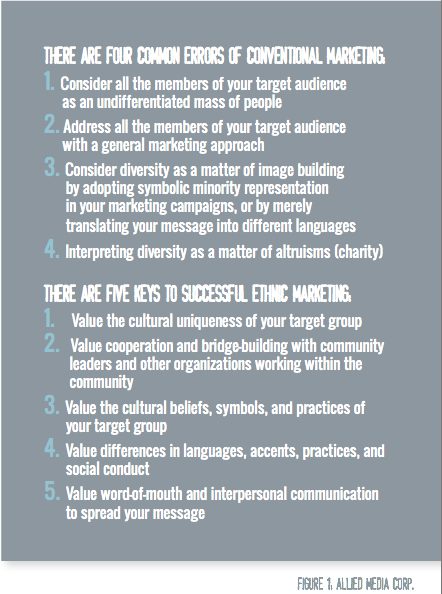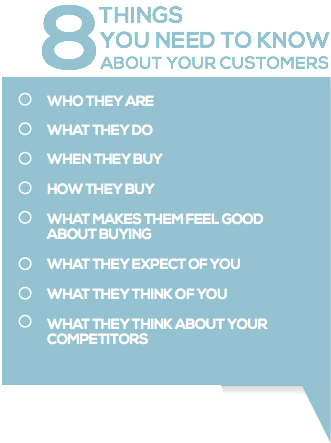
Imagine practicing archery blindfolded, or hunting with your eyes closed. Not that easy, if not impossible without seeing your target. The same concept can be applied to your business. Whether you are a business owner or thinking about opening a store, your business plan must include the following objectives: research and learn as much as you can about your target audience.
WHY TARGET?
Target marketing is particularly important for finding customers that fit your business, products and services. Because customers have different needs, tastes and wants, it is impossible to go after them all. While some only care about bargains, others look for novelties and trends. Target marketing and segmenting will help you identify various demographic groups. Demographics can include age, income, gender, education, ethnicity, geographic area and household size. One or many of these groups will be more likely to purchase your products than others because your business is more suitable and appealing to them. Because this process of defining your target can be a lengthy process, it is important that you know which segments represent the most potential sales for your business.

The purpose of target marketing is to make the promotion, pricing and distribution of your products and/or services easy to obtain and cost-effective. Target marketing provides a focus to all of your marketing activities and will significantly improve your sales.
WHAT ARE DEMOGRAPHICS?
GENERATIONS
Take into considerations the different generations of your area. Entrepreneur lists five distinct generations that will have different impacts on your marketing efforts:
Gen I, also called Gen Z and categorized as the “iGeneration,” is young and born entirely in the internet era.
Good to know: These consumers will be more receptive to any advertising using technology such as Groupon, Apps, QR Codes and so on.
Gen Y or “echo boomers” are between 9-27 years old and mostly live at home with their overprotective parents (the boomers). According to a study from the University of Michigan economics and public policy professor Bob Schoeni, they are 75 million and have disposable income because of their parents’ support. The research found that this generation processes information quickly and is especially brand loyal.
Good to know: The echo boomers like innovative marketing approaches and advertising that uses humor or thinks “outside the box,” and they are very responsive to internet campaigns.
Gen X, born between 1965–1975, represent 44 million and are in the peak of their earning and buying years. This generation loves to shop and is highly educated.
Good to know: The brand itself won’t persuade these customers who are looking more into the value of a product. Tech-savvy and independent, they also like to save. Therefore, promotions can be a good way to attract this target.
Boomers: This group of 76 million has an attractive buying power – they spend $400 billion more per year than other generations – a fact that doesn’t leave marketers insensible.
Good to know: The boomers are known for their Peter Pan complex and will not appreciate being categorized as “old!”
The Greatest Generation: The octogenarian generation has seen it all in term of advertising and is part of the most savvy consumer segment. They want to know more than other generations about your business and products and generally don’t “shop for fun.”
Good to know: Seniors aim at pleasing their grandchildren. They are also looking into products that will keep them active and that match their lifestyle.
GENDERS
“Men come from Mars and Women from Venus” and “Men buy, women shop.” You’ve heard this before. Indeed, men and women have different priorities when walking down the aisles. According to Wharton Marketing Professor Stephen J. Hoch, shopping behavior mirrors gender differences throughout many aspects of life. “Women think of shopping in an interpersonal, human fashion and men treat it as more instrumental. It’s a job to get done,” Hoch says. This gender difference has implications for retailers interested in developing a more segmented approach to build and maintain loyalty among male and female customers. “Marketing to Men vs. Women,” an article by Jennn Fusion posted on Chron.com outlines a few factors that affect gender buying behaviors:
Emotion vs. Function: Juniper Park, an ad agency from Toronto, says that women are looking for an emotional tactile experience while shopping. They also make purchase decisions considering their family needs or based on how the products are helping them feel accomplished. Men are more functional and look at how well products are meeting their requirements.
Brand vs. Price: According to a study from Massey University in 2008, women like to shop by comparing prices, hunt for bargains and prefer outlet store deals, whereas men would rather go shopping at traditional department stores to find their favorite brands without paying too much attention to prices.
Metro vs. Hetero: From a survey conducted by the ad company Leo Burnett Worldwide, the results show that 79 percent of men do not recognize themselves in advertisements today. Instead of using a sensitive, feminized man in the commercial, marketers should rather promote the functional, engineering and brand-name image of traditional “women products” such as beauty or housekeeping products to impact men, says Leo Burnett.
Detail vs. Simplicity: NeuroFocus, a company specializing in finding differences in brain-stimulus responses between men and women, explains some fundamental gender variations. For instance, women’s brains have stronger connections between both hemispheres so their languages and memory are strongly connected to their emotions. They also have a better recall of detailed information because of a larger hippocampus region. Therefore marketing towards women should emphasize details and emotional signals. Men, on the other side, have superior spatial abilities and problem- solving processes. They will be affected by design elements, but advertisers will have to keep it simple.
Feeling Important vs. Checking Out Fast: researchers at Wharton’s Jay H. Baker retail Initiative and the Verde Group, a Toronto consulting firm, found that women react more strongly than men to personal interaction with sales associates. For men, an associate’s interest in helping them find an item is most important, followed by the sales associate’s effort in getting them through checkout quickly. For women, store loyalty is related to sales associates’ familiarity with the products in the store and an ability to determine what products best suit the customer. Women shoppers also value sales associates who make them feel important.
The same study revealed that women are more likely to experience problems while shopping than men (53% vs. 48%). Women’s top problem will be the “lack of help when needed.” It is also the likeliest reason that stores lose the business of women shoppers. Men, however, ranked “difficulty in finding parking close to the store’s entrance” as the number one problem (29%). The problem most likely to result in lost business from men is if the product they came to buy is out of stock.
ETHNICITIES
Understanding diversity is crucial when developing your marketing strategies. When describing the American society, the concept of “salad bowl” is gradually replacing the concept of “melting pot.” While the “melting pot” was about the blending of cultures and people to become similar, the “salad bowl” combines cultures and people while keeping their individuality. This is why tailoring your messages to groups that have similar values, traditions, norms and beliefs is very important. Ethnic marketing takes into account ethnic diversity while conducting special marketing initiatives. It means adjusting your marketing strategies to the values, beliefs, attitudes, and practices of your different target ethnic groups. The main idea is to stay away from conventional marketing styles employed for a unique population. Allied Media Corp. lists the common errors from conventional marketing and the keys to successfully market different ethnicities (See Figure 1).

CLASSES
It is not new information that society is stratified into a number of different classes based on various criteria, and mainly on economic status. Here are the six layers: the upper upper and upper lower class, the upper middle and lower middle class, then the upper lower and the lower lower class. These are being used today by marketers to use different techniques when promoting and advertising products. According to RealBrandStrategies.com, the lower middle and the upper lower constitute the majority of the American population and represent most businesses’ target market.
From his market research, Lloyd Warner explains in his book Social Class in America that people who are part of the upper and upper middle classes tend to know what they want when they shop. They seem to be more organized when spending and research products before they buy. Therefore, most businesses that target this market will focus on personalized service in their stores.
Lloyd also found out that the lower classes tend to buy impulsively without really planning their purchases. Therefore they constitute a great target for brands that launch new products and concepts as these classes proved to be highly affected by trends.
Another interesting point raised by research marketers is that people tend to believe that most buyers prefer to buy from high-end stores, but in reality, customers tend to shop in stores where they feel comfortable rather than where they feel out of place. This is why considering social class in your target market is important.
The fact that we are all different makes the step of defining your target market quite complex, but you must know that assumptions won’t work here. Understanding your customers’ demographics and buying behaviors will greatly help you develop your business and drive your sales. Everyone is motivated by different factors when it comes to buying products or services, and you have to make sure that you are catering to your client’s needs and desires. Influences in decision-making will vary depending on one’s finances, personal taste or lifestyle.
HOW DO I GET THE DATA?
To successfully launch your business or increase your sales, you now realize that knowing everything about your products, your industry and your competitors is not enough. You have to know your customers. Marketers advise that you research and test the popularity of your products within a chosen community in different areas. You will have to find out their purchasing power, residences, means of transportation, ages, family status and leisure activities. A helpful tip to get detailed demographic information is to go on your location’s Census Bureau’s website. The Bureau of Labor Statistics will also give you an idea of how families spend their money in their publication “Consumer Expenditure.”
Steps to Target Customer Demographics
Based on author Rick Suttle’s article “How Do I Target Consumer Demographics,” here are 5 ways to get the info you need to succeed.
- Initiate marketing research on product usage and customer satisfaction. If your business is big enough you can work with a marketing research agency who will conduct the research within your budget. You can also ask the help of the person doing the marketing for you. Additionally, look at your POS system: can it allow you to input sales by type and additional info such as age and gender of the purchaser?
- Develop a questionnaire that asks about your products and services satisfaction with aspects such as price, quality, and customer service. Ask how often do they buy or likelihood to buy the products again. Questionnaire should include a page asking for gender, age, household size, occupation, education. Comment cards are an easy way to collect this, especially if they get a perk for filling it out.
- Study the results of your survey mechanisms. See which age, incomes and gender are most satisfied with your products.Also find out if these customers are the ones who buy your products the most often and come to your shop the most frequently. Determine if you have multiple target groups that are highly satisfied with your products.
- Segment your target customer groups by frequency of purchase. Determine the profile of your most loyal customer based on their satisfaction and purchases. Study all their characteristics such as activities, leisure,TV they watch, and household size. Observe and ask questions, small talk with customers makes them feel comfortable and listening to what the audience talks about in store will provide insight into their lives and likes.
- Develop marketing, promotional and advertising strategies to reach these key customers.Try as much as possible to update your research so you stay aware of emerging target groups and demographics.
All the markting research you have done should be part of your business plan and your target market should be aligned with their corresponding products. Remember, more than a competitor report, your data must include geographical frontiers, demographics, trends in your market and a marketing plan.
Resources and Further Reading:
Location, Location, Location. retrieved on February 15, 2013 from
http://www.netplaces.com/retail-store-guide/selecting-a-profitable-
location/location-location-location.htm
Know Your Target Market.retrieved on February 16,2013 from
http://www.entrepreneur.com/article/202334
Marketing to Men vs.Women. retrieved on February 11, 2013 from
http://smallbusiness.chron.com/marketing-men-vs-women-1011.html
Men Buy,Women Shop. retrieved on February 11, 2013 from
http://knowledge.wharton.upenn.edu/article.cfm?articleid=1848
Ethnic Marketing: A Strategy For Marketing Programs To Diverse Audience. retrieved on February11, 2013 from http://www.allied-media.com/marketingtodiverseaudience.html
Marketing For Different Social Classes. retrieved on February 12, 2013 from
http://realbrandstrategies.com/branding/marketing-for-different-social-classes/
Targeting Customer Demographics. retrieved on February 12, 2013 from
http://www.ehow.com/how_6008327_do-target-consumer-demographics_.html

